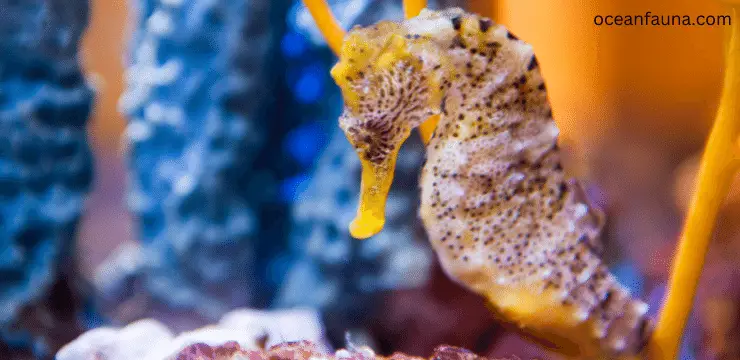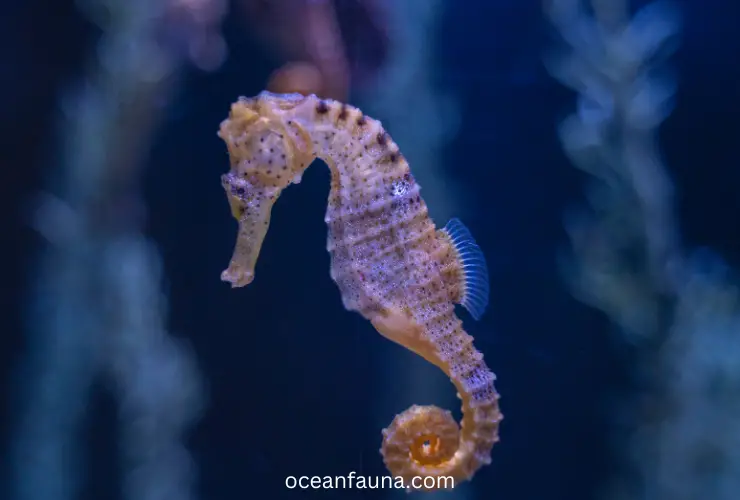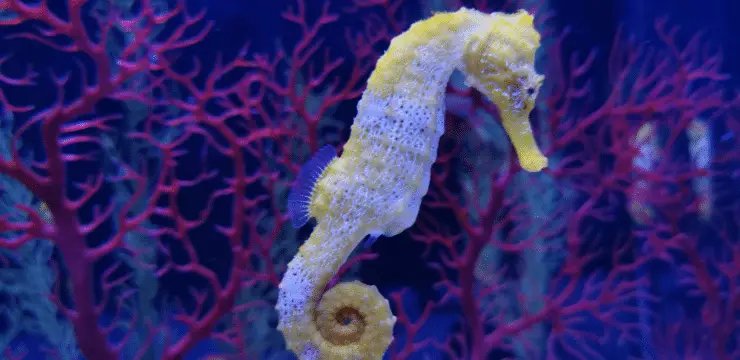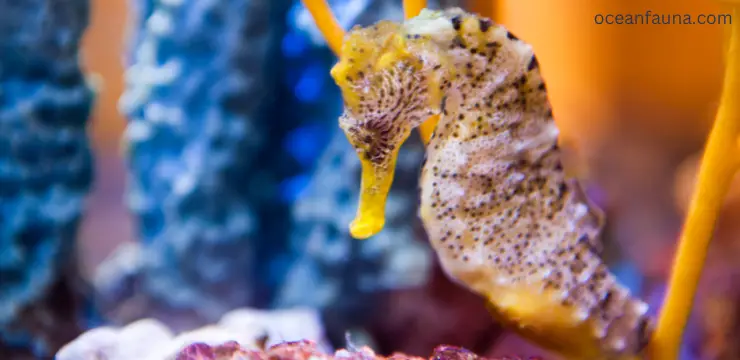In short, seahorses pose no threat to humans. However, they are highly efficient hunters, using their curled tails to capture small shrimp and fish.
In this article, we will explore if seahorses can be harmful to humans. We’ll also look at how they interact with us and any impact on our health.
Are Seahorses Dangerous to Mankind?
Seahorses are peaceful, slow-moving creatures and do not pose any threat to humans. They are also very small, averaging from 1.5 inches to 14 inches in size.
Also See: Do Seahorses Sleep? Secrets Of Seahorse Sleeping Behaviour
Seahorses primarily use their curled tails to hold onto seaweed or coral for camouflage and protection against predators rather than attacking humans.
Do Seahorses Bite?

No, seahorses do not bite. Their lack of teeth makes it impossible for them to bite anything, including humans. Their mouths, shaped like small tubes, are perfectly adapted for sucking up their food, such as shrimp, plankton, and small fish.
If you touch them, they might gently draw your finger into their mouth, instinctively, not as a bite. This behavior is their way of protecting themselves by blending into their surroundings.
Are Seahorses Poisonous to Touch?
No, seahorses are not poisonous to touch. But if they are bothered, they can release a yellow fluid to scare away predators. This fluid does not pose any threat to humans and can be easily rinsed off with water.
Sometimes, seahorses in aquariums spit out their food, which might have bad bacteria. In such situations, it’s crucial to wash your hands thoroughly after handling seahorses.
Despite their endearing appearance, wild seahorses are highly sensitive creatures. To avoid damaging them, it’s best not to touch them unless you have expert guidance.
In fact, in some countries, keeping seahorses as pets is prohibited due to their fragile disposition.
Can A Seahorse Kill a Human?
No, there are no recorded instances of a seahorse killing a human. Seahorses are small creatures that cannot bite because they lack teeth, as mentioned earlier. Additionally, they are not poisonous in any way.
Furthermore, seahorses are non-aggressive creatures that primarily engage in activities such as eating, hiding, and mating. They have no reason to attack or harm humans.
Moreover, these creatures are not known to carry any diseases harmful to humans. Thus, if you were to consume them, they would be safe.
Can Seahorses Recognize Humans?

Seahorses are known for their elusiveness, and their behavior in captivity may differ from their behavior in the wild. However, some studies suggest that seahorses might be capable of recognizing different individuals.
In one experiment, seahorses were shown photos of various human faces. Researchers observed that the seahorses tended to turn toward the photos of faces they had seen before. This suggests that seahorses can remember and distinguish between specific people.
For pet seahorses, the situation is interesting. When humans come near their aquarium, fish usually hide, but seahorses act differently. They will eventually come out to interact with you.
Another study even found that seahorses can distinguish between different human voices.
Impact Of Seahorses on Mankind
For centuries, humans have valued seahorses both as a source of food and in traditional medicine. Seahorses are unique creatures, making them popular in the aquarium business.
Seahorses are caught in some places and sold as dried or powdered because people want them. However, this high demand has resulted in excessive capture, leading to a decline in seahorse populations.
Consequently, seahorses are now listed as “vulnerable” on the IUCN Red List of Threatened Species. The potential loss of seahorses would be a significant concern, not only for these creatures but also for humanity.
Are Seahorses Dangerous for Other Animals?
Seahorses look unique and calm, but they are skilled hunters in the ocean. They have a long snout that helps them quickly and accurately suck up their prey from the water.
Their curved tail allows them to catch things, especially their food, such as shrimp and small fish. Despite their small size, seahorses are highly efficient hunters, allowing them to thrive in the ocean.
Seahorses can hide well and sneak up on prey because they blend in with surroundings.
Impact Of Seahorses on The Ecosystem

Seahorses have a unique role in marine ecosystems; they both serve as predators and are hunted as prey, making them integral to the food chain. They control the numbers of other animals, so some species don’t grow too much.
Furthermore, seahorses are keystone species for coral reefs. Their grazing activities play a crucial role in controlling the growth of algae, which, if left unchecked, can smother corals.
The absence of seahorses would lead to the degradation of coral reefs, with devastating consequences for the fish and other animals that rely on these reefs for sustenance and shelter.
What To Do to Save Seahorses?
Supporting eco-friendly fishing methods and conservation initiatives is crucial for seahorse and habitat conservation. Equally important is educating people about the significance of these animals and the threats they face.
If you want to keep seahorses as pets, do your research and only get captive-bred ones from reputable sources.
If we help protect seahorses and their homes, we can ensure they survive for future generations.
Conclusion
While seahorses do not harm people, it is important to protect them and employ sustainable harvesting methods.
If seahorses are not there, it could mess up the balance of the ocean. This would affect how much we rely on the ocean.


1 thought on “Are Seahorses Dangerous? [To Humans and Ecosystems]”